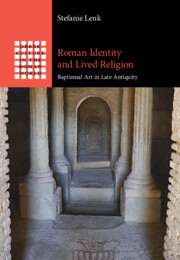Book contents
- Roman Identity and Lived Religion
- Greek Culture in the Roman World
- Roman Identity and Lived Religion
- Copyright page
- Dedication
- Contents
- Figures
- Acknowledgements
- Preface
- Abbreviations
- Introduction
- 1 The Absence of Christian Iconography and the Presence of Roman Cult and Culture in the Baptismal Complex of Cuicul, Numidia
- 2 The Use of Non-Christian Imagery in Baptisteries
- 3 The Conversion of a Personification
- Coda
- References
- Index
Introduction
Published online by Cambridge University Press: 08 February 2025
- Roman Identity and Lived Religion
- Greek Culture in the Roman World
- Roman Identity and Lived Religion
- Copyright page
- Dedication
- Contents
- Figures
- Acknowledgements
- Preface
- Abbreviations
- Introduction
- 1 The Absence of Christian Iconography and the Presence of Roman Cult and Culture in the Baptismal Complex of Cuicul, Numidia
- 2 The Use of Non-Christian Imagery in Baptisteries
- 3 The Conversion of a Personification
- Coda
- References
- Index
Summary
The Introduction provides an in-depth exploration of how late antique Christian communities in the Mediterranean reconciled their Roman and Christian identities through baptismal art. It raises pivotal questions: did such art serve to confirm both Roman and Christian identities? Could this art reflect a form of Christianity less orthodox due to its Roman cultural influences? Various case studies are presented, each spotlighting a different aspect of Roman cultural affiliation in baptismal spaces – ranging from the absence of explicitly Christian imagery to the inclusion of ‘pagan’ iconographies and classical motifs. Whether in Numidia, Lusitania, or Ravenna, these communities reveal a complex relationship with their Roman heritage, often challenging ecclesiastical norms. Despite the political disintegration of the western Roman Empire, the chapter underscores the extensive interconnectedness of the Mediterranean world, pointing out the shared cultural elements in baptismal art from the East to the far West. The chapter argues that these artistic choices are not mere coincidences but are indicative of a shared Roman culture that transcends geographical and political boundaries.
Keywords
- Type
- Chapter
- Information
- Roman Identity and Lived Religion , pp. 1 - 24Publisher: Cambridge University PressPrint publication year: 2025

